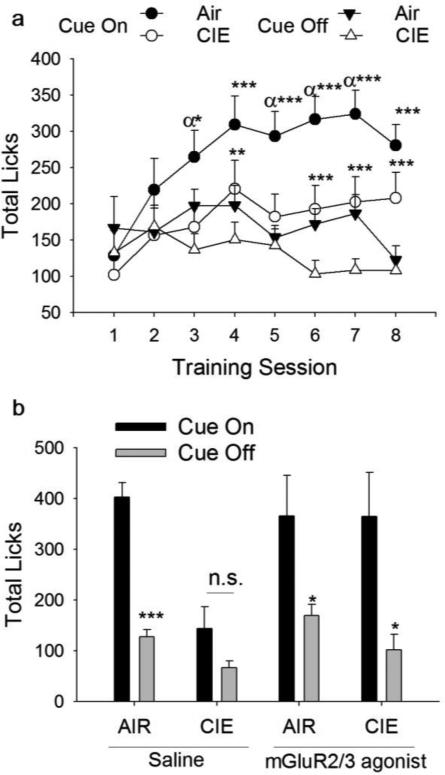Fig. 2.
Administration of an mGluR2/3 agonist reverses CIE-induced deficits in cue-guided behavior. (a) Chronic ethanol exposed mice were trained to associate a cue (tone) with delivery of a reinforcer (sucrose) for eight sessions. CIE exposed animals exhibited deficits in discrimination between cue-on and cue-off intervals (p = 0.05), suggesting impairments in the use of reward-paired cues to guide behavior. An effect of CIE was observed only on responding during the cue-on intervals, no difference was observed during the cue-off intervals between Air and CIE exposed mice. n = 23 (Air) and 24 (CIE). Cue-on vs cue-off; *p < 0.05, **p < 0.01, ***p < 0.001; Air cue-on vs CIE cue-on responding, αp < 0.05. Values represent mean ± SEM. (b) To probe the ability of an mGluR 2/3 agonist to reverse CIE-induced deficits, LY379268 was administered 30 min prior to a test session. Under saline conditions, CIE exposed mice did not discriminate between cue-on and cue-off intervals (p > 0.05) while Air controls responded at a significantly higher rate (p < 0.001). Administration of the mGluR2/3 agonist resulted in discrimination between cue-on and cue-off intervals in CIE animals (p < 0.05). Additionally, administration of the mGluR2/3 agonist normalized licking behavior in CIE mice such that licking during the cue-on intervals was equivalent to that observed in Air exposed controls. n = 7 (Air, Saline), 8 (Air, LY379268), 6 (CIE, Saline), 7 (CIE, LY379268), *p < 0.05, **p < 0.01, ***p < 0.001

